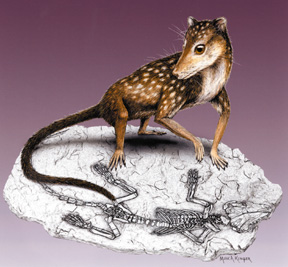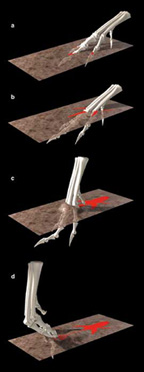geotimesheader
Highlights
Vertebrates
Maureen A.
O'Leary
Fossil vertebrate discoveries of 1999 belied Natural
History Museum in London paleontologist Andrew Smith’s prediction that
we have a “substantially biased fossil record that cannot be bettered no
matter where we go in the world.”
Smith’s statement, in the Dec. 2 Nature
supplement, sounded strange coming a month after D-G. Shu of Northwest
University in Xi’an, China, and colleagues tracked soft-bodied vertebrates
into the lower Cambrian. Who would have thought that before the millennium’s
close we would find fishes with intestines and blood vessels preserved
that were our closest relatives from the “‘Big Bang’ of life,” as Philippe
Janvier of the National Museum of Natural History in France described the
Cambrian explosion?
We often formulate ideas about how characters
evolve and about taxa we do not have, but history shows repeatedly that
such ideas are often wrong once evidence emerges. There is no substitute
in science for empiricism. Hypotheses of evolutionary transition and adaptation,
whether molecular or paleontological, are always in need of further corroboration
— or rejection.
The year of the fish
Conodonts rank among the oldest vertebrates in
the fossil record and were possibly the sister taxon to fishes. They remain
important for biostratigraphy but their tooth-like structures continue
to perplex functional morphologists. Even more intriguing, these taxa now
appear to have been capable of mammal-like closure of the teeth, or occlusion,
say Mark Purnell and Phil Donoghue of the University of Leicester in the
UK. The sophistication of conodont occlusion is striking because they lack
jaws. The discovery of this convergence not only implies complex feeding
in this basal clade but also challenges how we interpret the uniqueness
of mammalian mastication.
The abrupt appearance of animal phyla known as
the Cambrian explosion has not, until now, been particularly informative
about the origins of vertebrates. Shu and colleagues recently described
a new Lagerstätten of the oldest vertebrates from the Early Cambrian
Chengjiang beds of China: delicate little non-mineralized animals that
feature vertebrate structures like a cartilaginous skull, gills (indirect
evidence for neural crest cells), and complex muscle blocks.
Enigmatic taxa representing basal bony fishes
have changed how we identify ray-finned or lobe-finned fish. Bony fishes
have the most species of any vertebrate clade and to understand how and
when these fish emerged, what the earliest forms looked like, and how they
split into ray-finned and lobe-finned forms is to clarify an extremely
significant radiation in vertebrate history. Min Zhu of the Institute of
Vertebrate Paleontology in Beijing and colleagues extended the record of
bony fishes to the Latest Silurian/Earliest Devonian period. Their specimen
forces a reevaluation of our diagnoses of the clades of bony fishes. It
contains a mixture of characters previously thought to belong uniquely
to either the lobe-finned fishes Sarcopterygii or to the ray-finned
Actinopterygii fishes.
Finally, new fish fossils from the Paleozoic of
Canada exhibit a variety of morphological structures interpretable as pelvic
and pectoral fins. These structures are critical to our understanding of
fish locomotion, adaptation and, ultimately, the origin of tetrapods. Mark
Wilson of the University of Alberta in Edmonton argues that these fossils
have fin-like structures located in unanticipated positions and challenge
our assessment of the origin and evolution of fins.
Amniote Lagerstätten
Exquisite preservation became
the rule for many new amniote discoveries (birds, reptiles, mammals or
any other group of vertebrates that undergoes embryonic development within
a thin membrane forming a closed sac, or amnion). The dromaeosaurid theropod
Sinornithosaurus
from the Cretaceous of China described by Xing Xu of the Institute of Vertebrate
Paleontology and Paleoanthropology of Beijing, and colleagues, preserved
a covering of filaments, demonstrating the presence of feather-like structures
similar to birds. Due to the position of this fossil on the theropod phylogenetic
tree, we have a working hypothesis that a number of theropod taxa between
it and birds also had feathers. Excellent preservation of Triassic theropod
footprints from Greenland provided Stephen Gatesy of Brown University and
colleagues with one of the most direct means of reconstructing foot movement
in this long-extinct dinosaur clade. |

Color reconstruction of Jeholodens jenkinsi on its fossil slab as
preserved in the stone. Watercolor image and fossil assembled
on computer.
Mark A. Klinger, Carnegie Museum of Natural History. |
The most complete skeleton ever found of a triconodont
— a clade of mammals from the Mesozoic that is so primitive that it represents
a stem taxon outside of monotremes, marsupials and placentals — emerged
from work by Ji Qiang of the National Geological Museum of China and colleagues
(see above illustration of Jeholodens jenkinsi). Despite its basal
position on the mammalian tree (dictated by many parts of its skeleton),
it has features of the shoulder that resemble some living mammals but appear
to have evolved convergently. Each of these discoveries records the experimentation
characterizing the early radiation of various living amniote clades.

3-D computer reconstruction
of theropod foot movements through sloppy mud. Penetration through
the ground surface is shown in red. The first toe, which is not reversed
as in modern birds, creates a rearward-pointing furrow (a, b) as it plunges
down and forward. The sole of the foot leaves an impression at the back
of the track (c) beacause it is not lifted as the foot sinks. All toes
converge below the surface and emerge together from the front of the track
(d). From work published by Steven Gatesy in the May 13, 1999 Nature. See
also Geotimes, July 1999. Stephen Gatesy, Brown University. |
Cladogram construction
Using simulations with a known phylogeny, David Fox and colleagues
of the University of Michigan found that they more frequently recovered
the correct phylogeny by applying stratocladistics rather than cladistics.
In stratocladistics, one reconstructs a phylogeny using stratigraphic (temporal)
data in parsimony analysis as cladistic character, like nucleotides, bony
landmarks or other features of a taxon. These authors argue that this method
explains more observations about life in the past. Despite this important
result, others continue to object to the inclusion of stratigraphic data
in phylogeny reconstruction and may not immediately embrace simulations
as complex enough to generalize to empirical situations.
If Quaternary extinctions of large terrestrial
animals resulted from extreme global climate change, rather than human
hunting, then one would predict that taxa that go extinct do so at times
of dramatic climate change. Intensified study with excellent temporal control
of the fossil record of a 100-kilogram flightless bird from the Late Pleistocene
of Australia by Gifford Miller of the University of Colorado at Boulder
and colleagues showed that the bird’s extinction occurred around 50,000
years ago throughout its Australian range. Because this date coincides
with the arrival of humans in Australia but not with any intense climate
fluctuations, it becomes relatively unambiguous evidence against a significant
causal role for climate in this Quaternary extinction. |
Extinctions
If Quaternary extinctions of large terrestrial
animals resulted from extreme global climate change, rather than human
hunting, then one would predict that taxa that go extinct do so at times
of dramatic climate change. Intensified study with excellent temporal control
of the fossil record of a 100-kilogram flightless bird from the Late Pleistocene
of Australia by Gifford Miller of the University of Colorado at Boulder
and colleagues showed that the bird’s extinction occurred around 50,000
years ago throughout its Australian range. Because this date coincides
with the arrival of humans in Australia but not with any intense climate
fluctuations, it becomes relatively unambiguous evidence against a significant
causal role for climate in this Quaternary extinction.
This litany of discoveries from the spectrum of
vertebrate life should hearten those distressed by such setbacks to evolutionary
study as the decision last fall by the Kansas Board of Education to eliminate
evolution from the state’s school curriculum. Many Kansas universities
openly opposed the decision, and the Society of Vertebrate Paleontology
maintains publicly that the theory of evolution is highly corroborated
by our observations of the fossil record (see www.museum.state.il.us/svp//).
Continued discovery, study and popularization of material as extraordinary
as that described in 1999 will undoubtedly generate great interest in the
vertebrate stratigraphic record and may serve to teach about evolution,
even if not in school.
O'Leary is an assistant professor
in the Department of Anatomical Sciences at the State University of New
York, Stony Brook. She studies mammalian evolution and conducts fieldwork
in the Late Mesozoic and Early Cenozoic rocks of sub-Saharan Africa, attempting
to recover poorly known vertebrate fossils.


